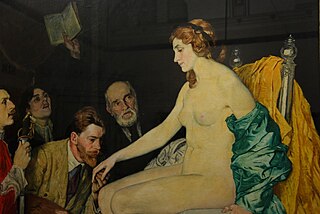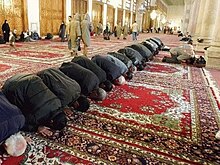
A kowtow is the act of deep respect shown by prostration, that is, kneeling and bowing so low as to have one's head touching the ground. In Sinospheric culture, the kowtow is the highest sign of reverence. It was widely used to show reverence for one's elders, superiors, and especially the Emperor of China, as well as for religious and cultural objects of worship. In modern times, usage of the kowtow has been reduced.

A salute is usually a formal hand gesture or other action used to display respect in military situations. Salutes are primarily associated with the military and law enforcement, but many civilian organizations, such as Girl Guides, Boy Scouts and the Salvation Army use formal salutes. Ordinary civilians also salute informally to greet or acknowledge the presence of another person, such as a tip of the hat or a hand wave to a friend or neighbour.

Genuflection or genuflexion is the act of bending a knee to the ground, as distinguished from kneeling which more strictly involves both knees. From early times, it has been a gesture of deep respect for a superior. Today, the gesture is common in the Christian religious practices of the Anglicanism, Lutheranism, the Catholic Church, and Western Rite Orthodoxy. The Latin word genuflectio, from which the English word is derived, originally meant kneeling with both knees rather than the rapid dropping to one knee and immediately rising that became customary in Western Europe in the Middle Ages. It is often referred to as "going down on one knee" or "bowing the knee". In Western culture, one genuflects on the left knee to a human dignitary, whether ecclesiastical or civil, while, in Christian churches and chapels, one genuflects on the right knee when the Sacrament is not exposed but in a tabernacle or veiled.

Proskynesis, proscynesis, or proskinesis was a solemn gesture of respect for the gods and people; among the Persians, it referred to a man prostrating himself and kissing the earth, or the limbs of a respected person. Proskynesis (adoratio) was one of the religious rites of the Greeks and Romans.

A prayer rug or prayer mat is a piece of fabric, sometimes a pile carpet, used by Muslims, some Christians, especially in Orthodox Christianity and some Baha'i during prayer.
A Rak'ah is a single iteration of prescribed movements and supplications performed by Muslims as part of the prescribed obligatory prayer known as salah. Each of the five daily prayers observed by Muslims consists of a number of raka'at.

In Christianity, worship is the act of attributing reverent honour and homage to God. In the New Testament, various words are used to refer to the term worship. One is proskuneo which means to bow down to God or kings.

Kneeling is a basic human position where one or both knees touch the ground. Kneeling is defined as “to position the body so that one or both knees rest on the floor,” according to Merriam-Webster. Kneeling when only composed of one knee, and not both, is called genuflection.

Adoration is respect, reverence, strong admiration, or love in a certain person, place, or thing. The term comes from the Latin adōrātiō, meaning "to give homage or worship to someone or something".

Sujūd, or sajdah, is the act of low bowing or prostration to (God) facing the qiblah. It is usually done in standardized prayers (salah). The position involves kneeling and bowing till one touches the ground with 7 bones (points): the forehead & nose, two hands, two knees and two sets of toes. In accordance with the Sunnah of Muhammad, one's elbows should be far from one's body, unless it causes discomfort to other worshippers. Some scholars hold the position that this applies only to men, and that women are encouraged to tuck their elbows in out of modesty,
The different kinds of bows one could encounter at an Eastern Orthodox service are shown in the drawing below.

Rukūʿ can refer to either of two things in Islam:
The text and rubrics of the Roman Canon have undergone revisions over the centuries, while the canon itself has retained its essential form as arranged no later than the 7th century. The rubrics, as is customary in similar liturgical books, indicate the manner in which to carry out the celebration.

Prostration is the gesture of placing one's body in a reverentially or submissively prone position. Typically prostration is distinguished from the lesser acts of bowing or kneeling by involving a part of the body above the knee, especially the hands, touching the ground.
A prostration is a gesture used in Buddhist practice to show reverence to the Triple Gem and other objects of veneration.
Eastern Orthodox worship in this article is distinguished from Eastern Orthodox prayer in that 'worship' refers to the activity of the Christian Church as a body offering up prayers to God while 'prayer' refers to the individual devotional traditions of the Orthodox.

Dogeza (土下座) is an element of traditional Japanese etiquette which involves kneeling directly on the ground and bowing to prostrate oneself while touching one's head to the floor. It is used to show deference to a person of higher status, as a deep apology or to express the desire for a favor from said person.

Sembah is an Indonesian greeting and gesture of respect and reverence. While performing the sembah, one clasps their palms together solemnly in a prayer-like fashion called suhun or susuhun in Javanese; or menyusun jari sepuluh in Indonesian and Malay, placing them in front of their chest and moving the pressed palms up to their chin, or all the way up until their thumbs touch the tip of their nose, while bowing slightly. Any of these two forms are made depending on the status of the person greeted.

Bowing in Japan is the act of lowering one's head or the upper part of the torso, commonly used as a sign of salutation, reverence, apology or gratitude in social or religious situations.


















